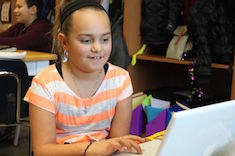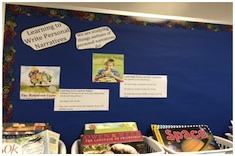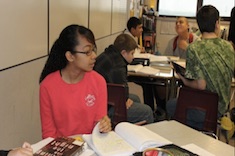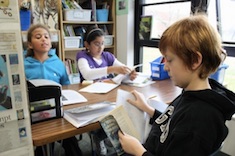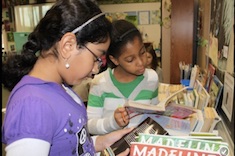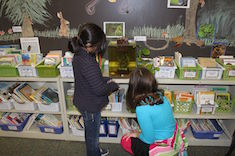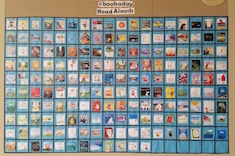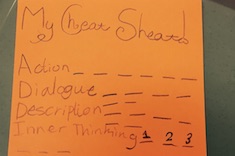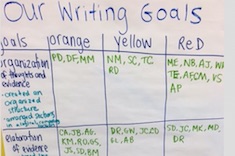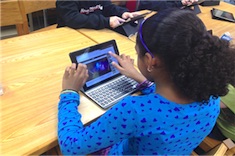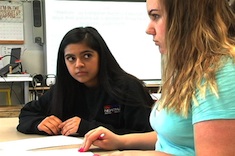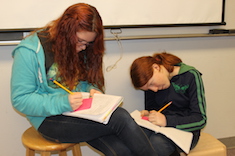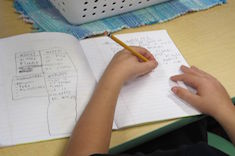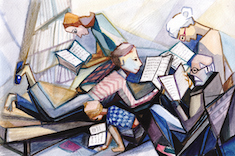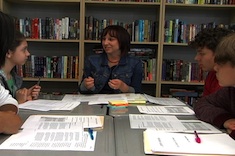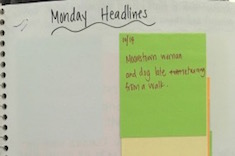Articles
Here is where you’ll find all the latest print features from our contributors. If you’d like to browse specifically by grade level, topic, or contributor, you can use the links in the right sidebar.
Latest Content
Is Writing Essential?
Ruth Ayres shares some of the powerful connections between stories and writing workshops.
School-to-Home Journals
Are you considering school-to-home journals in your classroom this year? Jennifer Schwanke describes how these notebooks build community and literacy skills.
Dabbling: Reviving a Focus on Play
Mary Lee Hahn finds a focus on play and "dabbling" renews student writers during a unit on narrative nonfiction.
Planning for a Narrative Writing Unit of Study
Franki Sibberson believes planning a unit of study should be just as much fun as planning a trip to Disney World. She explains her planning process for one of her first units of study, on narrative writing.
Humor Writing with Teens
Gretchen Schroeder develops a unit on humor writing that engages and delights her high school students.
Creating a Manifesto
Ruth Ayres explains why writing a manifesto may be the best way to learn what you truly believe about teaching, learning, and literacy.
My Five Objectives for the Start of the School Year
Gretchen Schroeder winnows many competing demands at the start of the year down to five clear objectives in her high school classroom.
Reading Workshop Non-Negotiables
Scott Jones finds working with a student teacher forces him to explain what the “non-negotiables” are in his reading workshop.
Joy
Katrina Edwards deals with a frustrated writer on the verge of tears in her first-grade classroom. She realizes the element that is missing in her writing workshop is joy.
Reconsidering Reading Workshop Routines
Andrea Smith realizes her normal reading routine will not work within the constraints of this year’s schedule. She makes some radical changes to ensure she and her students can have enough time to find the joy in reading and building a literate community.
Sketchnoting as a Response to Reading
Dana Murphy tries sketchnoting during professional development, and soon finds herself sharing the fun technique with students. They hone their skills during read alouds and while annotating texts.
The Benefits of #bookaday
Franki Sibberson finds the investment of five to seven minutes a day for #bookaday with her third graders is truly time well spent.
#bookaday in Middle School
Jillian Heise rises to the challenge of reading a new picture book to her seventh and eighth graders each day all year long.
Student-Designed Development Cards
Melanie Meehan finds that student-designed development cards are a great way to get students invested in literacy goals.
Practical Ways to Connect Students and Goals
Kate Mills and Tara Barnett provide some practical tips for connecting students and goals.
The Basics of Teaching Internet Search Skills to Children
Bill Bass provides a range of search options for students, and encourages teachers to promote different tools in different contexts.
Video Games and Literacy
Matt Renwick finds there is value in connecting video games and literacy in classrooms, once he and the teachers he works with can get past their leeriness.
The iPad Is 7
Jennifer Schwanke reflects upon how the iPad and other touchscreen devices have changed the way children interact with all texts, even traditional storybooks.
Tapping into What Students Know
Melanie Meehan shares the value of assessing what students know first, and then tapping into this knowledge in new units.
Consistent Feedback in Writing Workshop
Carly Ullmer assesses how she can give consistent and meaningful feedback to every one of her many middle school students at least once a week.
Expert Students
Christy Rush-Levine uses a quick assessment during writing workshop conferences to connect expert students with peers who might need assistance. She includes a video example of the practice.
Creating an On-Demand Writing Checklist
On-demand writing can be a stressful assessment task for students, but it does mimic the type of writing many adults face in their professional lives. Tara Barnett and Kate Mills work with students to create an on-demand writing checklist.
Assessing Instruction in the Midst
Melanie Meehan shares some ways teachers can press the pause button in the midst of teaching to assess whether they are teaching the right lesson at the right time.
Explaining a Workshop Model to Parents (Part 2)
ennifer Schwanke explains how jargon can trip up communication with parents, and lists which terms are worth defining. This is the final installment of her series on talking about literacy workshops with families.
Building Community and Family Connections
Tara Barnett and Kate Mills share suggestions for connecting with parents over the summer and early in the school year, including some fun uses of technology.
Literary Analysis: Tone and Scholarly Writing
Christy Rush-Levine shares how to help student writers understand and develop a scholarly tone. The feature includes a video example of small-group instruction.
Explaining a Workshop Model to Parents
Jennifer Schwanke explains why parent-teacher conferences can be bewildering for families, and offers advice for better ways to explain a literacy workshop model to them.
Monday Headlines
Tara Barnett and Kate Mills use Monday Headlines to energize students after the weekend, and get a peek into what’s going on at home.
Literary Analysis: Counterclaims
Christy Rush-Levine shares how to present counterclaims, as well as a video example of a small group exploring counterclaims.
Mentor Texts and Important Reminders
Melanie Meehan shares four important tips for using mentor texts effectively with students of any age.
Browse Content By
Type
Category
- Assessment Tools
- Big Fresh Archives
- Booklists
- Choice Numeracy
- Classroom Design
- Common Core
- Community Building
- Conferring
- Content Literacy
- Digital Literacy
- English Language Learners
- Equity
- Family Relations
- Free Samples
- Guiding Groups
- Leadership
- Literacy Coaches
- Mentor Texts
- Minilessons
- New Teacher Mentors
- Podcasts
- Poetry
- Quote Collections
- Reading Strategies
- Self Care
- Struggling and Striving Learners
- Talking and Listening
- Teacher Study Groups
- Teaching Reading
- Teaching Writing
- Word Study and Vocabulary
Author
- Melissa Quimby
- Nawal Qarooni
- Gwen Blumberg
- Julie Cox
- The Lead Learners
- Hannah Tills
- Josie Stewart
- Ruth Metcalfe
- Mallory Messenger
- Becca Burk
- Jodie Bailey
- Vivian Chen
- Mary Brower
- Tiffany Abbott Fuller
- Stephanie Affinito
- Ruth Ayres
- Leigh Anne Eck
- Heather Fisher
- Shari Frost
- Julie Johnson
- Suzy Kaback
- Gigi McAllister
- Shirl McPhillips
- Melanie Meehan
- Cathy Mere
- Debbie Miller
- Tara Barnett and Kate Mills
- Tammy Mulligan
- Dana Murphy
- Bitsy Parks
- David Pittman
- Brenda Power
- Heather Rader
- Matt Renwick
- Mandy Robek
- Christy Rush-Levine
- Gretchen Schroeder
- Jen Schwanke
- Brian Sepe
- Katherine Sokolowski
- Stella Villalba
- Jennifer Vincent
Grade Level
Choice Literacy Membership
Articles
Get full access to all Choice Literacy article content
Videos
Get full access to all Choice Literacy video content
Courses
Access Choice Literacy course curriculum and training



